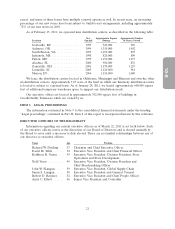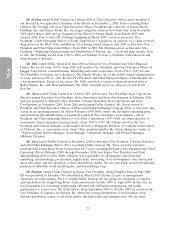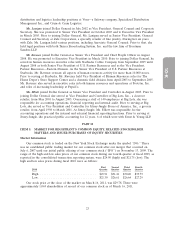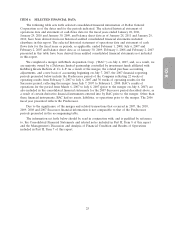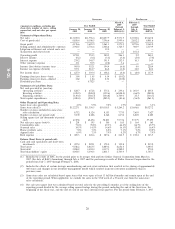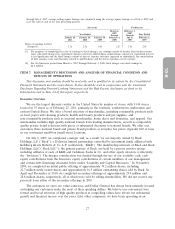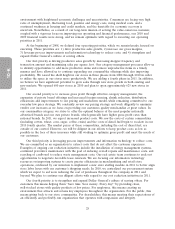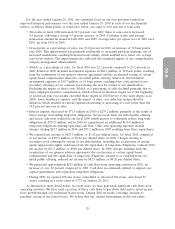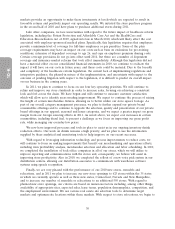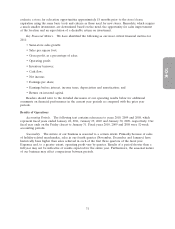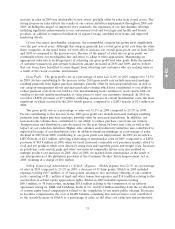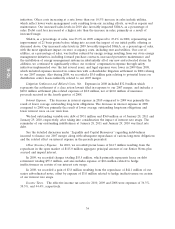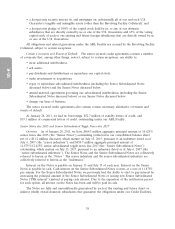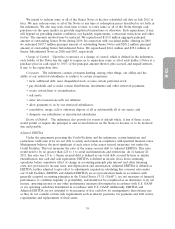Dollar General 2010 Annual Report Download - page 108
Download and view the complete annual report
Please find page 108 of the 2010 Dollar General annual report below. You can navigate through the pages in the report by either clicking on the pages listed below, or by using the keyword search tool below to find specific information within the annual report.
10-K
markets provides an opportunity to make these investments at levels which are expected to result in
favorable returns and positively impact our operating results. We initiated the store purchase program
in the second half of 2010 and have plans to purchase additional stores during 2011.
Like other companies, we face uncertainties with regard to the future impact of healthcare reform
legislation, including the Patient Protection and Affordable Care Act and the HealthCare and
Education Reconciliation Act of 2010, signed into law in March 2010, which will likely affect the cost
associated with employer-sponsored medical plans. Specifically, this legislation requires that employers
provide a minimum level of coverage for full-time employees or pay penalties. Some of the plan
coverage requirements may have an impact on our costs such as bans on exclusions for pre-existing
conditions, extension of dependent coverage to age 26, and caps on employee premium sharing costs.
Certain coverage provisions do not go into effect until 2014, but there are a number of dependent
coverage and insurance market reforms that took effect immediately. Although this legislation did not
have a material effect on our consolidated financial statements in 2010, we continue to evaluate the
impact it will have on our costs in future years, and those costs could be material. Due to the breadth
and complexity of the healthcare reform legislation, the current lack of implementing regulations and
interpretive guidance, the phased-in nature of the implementation, and uncertainty with respect to the
outcome of pending litigation with respect to the legislation, it is difficult to predict its overall impact
on our business in the coming years.
In 2011, we plan to continue to focus on our four key operating priorities. We will continue to
refine and improve our store standards in order to increase sales, focusing on achieving a consistent
look and feel across the chain. We have begun and will continue to measure customer satisfaction
which will allow us to identify areas needing improvement. We expect to continue the process of raising
the height of certain merchandise fixtures, allowing us to better utilize our store square footage. As
part of our overall category management processes, we plan to further expand our private brand
consumables offerings and to continue to upgrade the selection, quality and presentation of our private
brand offerings in our apparel, seasonal and home categories, and we expect a greater impact on gross
margin from our foreign sourcing efforts in 2011. As noted above, we expect cost increases in certain
commodities, including diesel fuel, to present a challenge as we focus on improving our gross profit
rate, while managing our everyday low prices.
We now have improved processes and tools in place to assist us in our ongoing inventory shrink
reduction efforts. Our work on shrink remains a high priority, and we plan to use the information
supplied by these analytical and monitoring tools to help improve on our recent successes.
With regard to leveraging information technology and process improvements to reduce costs, we
will continue to focus on making improvements that benefit our merchandising and operations efforts,
including item profitability analysis, merchandise selection and allocation and labor scheduling. In 2010,
we completed the installation of back office computers in all of our stores, which we will utilize to
improve reporting and communications with the stores and, consequently, we believe will assist in
improving store productivity. Also in 2010, we completed the rollout of a new voice pick system in our
distribution centers, allowing our distribution associates to communicate with warehouse software
systems using speech recognition.
Finally, we are very pleased with the performance of our 2010 new stores, remodels and
relocations, and in 2011 we plan to increase our new store openings to 625 stores within the 35 states
in which we currently operate as well as three new states, Connecticut, Nevada and New Hampshire,
and to increase our number of remodels or relocations to an additional 550 stores. With regard to
planned new store openings, our criteria are based on numerous factors including, among other things,
availability of appropriate sites, expected sales, lease terms, population demographics, competition, and
the employment environment. We use various real estate site selection tools to determine target
markets and optimum site locations within those markets. With respect to store relocations, we begin to
30



